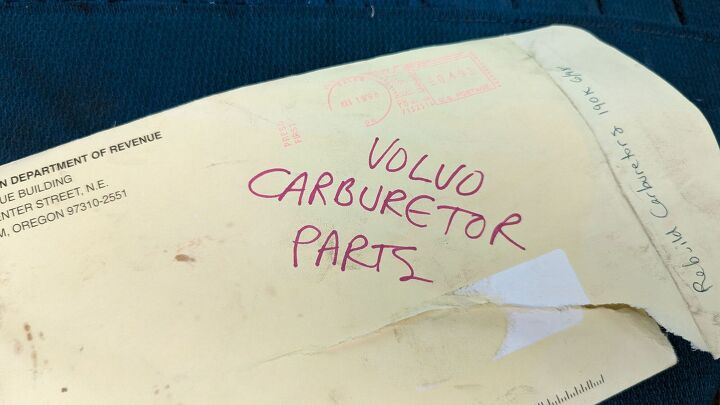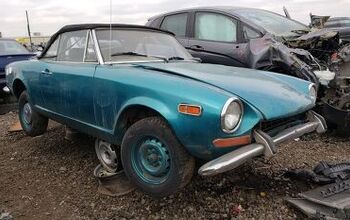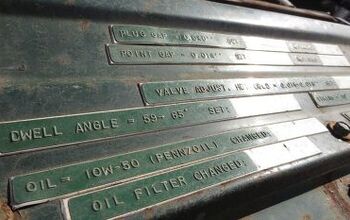Junkyard Find: 1970 Volvo 145

Because Volvo sold the 200 Series cars here from the 1975 through 1993 model years and so many owners loved those sensible bricks so deeply, plenty are only now showing up in the self-service car graveyards I frequent. What about the 200's predecessor, the 140?
While not as easy to find as the 240 in Ewe Pullet yards these days, I still run across one or two 140s in junkyards per year, mostly in Volvo brick-loving Northern California. This one now resides in the same San Jose Pick-n-Pull as three Renault Dauphines (including a Gordini).
If you go there, make sure you get some tacos from the roach coach out front; it's one of the best junkyard taco trucks in the Golden State (which is saying something).
Like so many old Volvos I've found in junkyards in recent years (including a 240 with better than 600,000 miles on the odometer), this one has the look of a car that spent most or all of its life with one owner who loved it very much.
It's very well-preserved, with seats swapped in from what I assume was an early 240 and other signs of meticulous care for a reliable, if elderly daily driver. For example, this envelope with some carb gaskets I found in the glovebox.
On the back is a lengthy description of the details associated with a very careful rebuild of the Skinners Union carburetors.
Having daily-driven a few cars equipped with dual SUs, I know and love/hate this hardware quite well (and I can say that the license-built Hitachi versions used on Datsuns have far superior build quality).
Volvo was an early adopter of the six-digit odometer, so we can see that this car traveled close to 250,000 miles during its life. Did the owner finally trade it in on a new Volvo?
Plenty of curmudgeonly Silicon Valley tech-industry workers drove old Swedish cars to work for decade after decade.
The 140 and 240 Volvos were essentially the same car from the A pillar back, as is made clear from the side view. The 200 Series ( which included the 260 six-cylinder cars) got a modern MacPherson strut front suspension but otherwise didn't change much.
All the 140s got B18 and B20 pushrod straight-four engines, continuing the tradition of tractor-grade B-series Volvo power that went all the way back to the PV444s of the middle 1940s (and through the US-market PV544 and Amazon).
The 240 got the B20 here as well, though only for the 1975 model year. After that, the 240 went all overhead-cam. There were six-cylinder members of the 140 family, but only in sedan form.
140s with automatics were available, of course, but this car has the four-on-the-floor manual you'll find in most of these cars.
The old-school aftermarket AM radio shows "BC" (which meant "Broadcast") and "KC" (which stood for "kilocycles" rather than the kilohertz nomenclature established in 1960 by the Systéme international d'unités).
What was the last year in which you could buy a new car in the United States with a manual choke lever from the factory? It couldn't have been much later than the early 1970s.
How could a classic Volvo this solid have ended up in a place like this? Why didn't someone buy it for cheap and drive it to a place like Michigan or Vermont, where some say that Volvo fanatics will pay five figures for any rust-free 145 or 245? That was money left on the table!
Sadly, most of those fanciers of Swedish bricks in the territory of the Rust Monster already have a dozen or three project cars and they tend to be weapons-grade tightwads when it comes to buying Volvos and/or Volvo parts. A very nice running 145 might fetch acceptable money in the real world, but not enough to make a car like today's Junkyard Find a good investment from a strictly financial viewpoint.
1970 Volvo 145 in California junkyard.
1970 Volvo 145 in California junkyard.
1970 Volvo 145 in California junkyard.
1970 Volvo 145 in California junkyard.
1970 Volvo 145 in California junkyard.
1970 Volvo 145 in California junkyard.
1970 Volvo 145 in California junkyard.
1970 Volvo 145 in California junkyard.
1970 Volvo 145 in California junkyard.
1970 Volvo 145 in California junkyard.
1970 Volvo 145 in California junkyard.
1970 Volvo 145 in California junkyard.
1970 Volvo 145 in California junkyard.
1970 Volvo 145 in California junkyard.
[Images: The Author]
Become a TTAC insider. Get the latest news, features, TTAC takes, and everything else that gets to the truth about cars first by subscribing to our newsletter.

Murilee Martin is the pen name of Phil Greden, a writer who has lived in Minnesota, California, Georgia and (now) Colorado. He has toiled at copywriting, technical writing, junkmail writing, fiction writing and now automotive writing. He has owned many terrible vehicles and some good ones. He spends a great deal of time in self-service junkyards. These days, he writes for publications including Autoweek, Autoblog, Hagerty, The Truth About Cars and Capital One.
More by Murilee Martin
Latest Car Reviews
Read moreLatest Product Reviews
Read moreRecent Comments
- Varezhka I have still yet to see a Malibu on the road that didn't have a rental sticker. So yeah, GM probably lost money on every one they sold but kept it to boost their CAFE numbers.I'm personally happy that I no longer have to dread being "upgraded" to a Maxima or a Malibu anymore. And thankfully Altima is also on its way out.
- Tassos Under incompetent, affirmative action hire Mary Barra, GM has been shooting itself in the foot on a daily basis.Whether the Malibu cancellation has been one of these shootings is NOT obvious at all.GM should be run as a PROFITABLE BUSINESS and NOT as an outfit that satisfies everybody and his mother in law's pet preferences.IF the Malibu was UNPROFITABLE, it SHOULD be canceled.More generally, if its SEGMENT is Unprofitable, and HALF the makers cancel their midsize sedans, not only will it lead to the SURVIVAL OF THE FITTEST ones, but the survivors will obviously be more profitable if the LOSERS were kept being produced and the SMALL PIE of midsize sedans would yield slim pickings for every participant.SO NO, I APPROVE of the demise of the unprofitable Malibu, and hope Nissan does the same to the Altima, Hyundai with the SOnata, Mazda with the Mazda 6, and as many others as it takes to make the REMAINING players, like the Excellent, sporty Accord and the Bulletproof Reliable, cheap to maintain CAMRY, more profitable and affordable.
- GregLocock Car companies can only really sell cars that people who are new car buyers will pay a profitable price for. As it turns out fewer and fewer new car buyers want sedans. Large sedans can be nice to drive, certainly, but the number of new car buyers (the only ones that matter in this discussion) are prepared to sacrifice steering and handling for more obvious things like passenger and cargo space, or even some attempt at off roading. We know US new car buyers don't really care about handling because they fell for FWD in large cars.
- Slavuta Why is everybody sweating? Like sedans? - go buy one. Better - 2. Let CRV/RAV rust on the dealer lot. I have 3 sedans on the driveway. My neighbor - 2. Neighbors on each of our other side - 8 SUVs.
- Theflyersfan With sedans, especially, I wonder how many of those sales are to rental fleets. With the exception of the Civic and Accord, there are still rows of sedans mixed in with the RAV4s at every airport rental lot. I doubt the breakdown in sales is publicly published, so who knows... GM isn't out of the sedan business - Cadillac exists and I can't believe I'm typing this but they are actually decent - and I think they are making a huge mistake, especially if there's an extended oil price hike (cough...Iran...cough) and people want smaller and hybrids. But if one is only tied to the quarterly shareholder reports and not trends and the big picture, bad decisions like this get made.































































Comments
Join the conversation
Hey fellow junker! Any chance you remember where that Colony Park was I'm dreaming that maybe it's just still sitting there haha
Toyota Land Cruiser FJ60 had manual choke through 1987.
Also, just started daily driving my 1992 Volvo 240 that I picked up in September and brought back to the road. Some fresh studded tires + RWD, bring on the snow!! Old Volvos make me smile